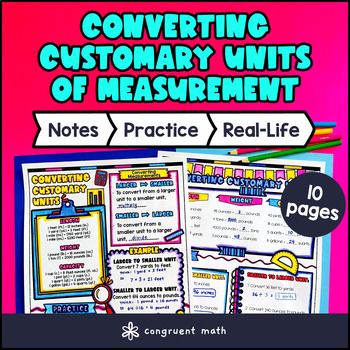Want more ideas and freebies?
Get my free resource library with digital & print activities—plus tips over email.
Join for Free Resources →
$4.25
Ever wondered how to teach customary units of measurement conversions in an engaging way to your 4th and 5th grade students?
In this lesson plan, students will learn about converting customary units and their real-life applications. Through artistic, interactive guided notes, checks for understanding, a doodle and color-by-number activity, and a maze worksheet, students will gain a comprehensive understanding of measurement conversions.
The lesson culminates with a real-life example that explores how converting measurements is used in everyday situations, helping students see the practical value of this math skill.

$4.25
After this lesson, students will be able to:
Before this lesson, students should be familiar with:
As a hook, ask students why it is important to be able to convert customary units of measurement in real life. For example, ask: “Have you ever needed to know how many feet are in a yard to measure your garden, or how many cups are in a pint when cooking?” Refer to the last page of the guided notes for additional real-life examples and the FAQs below for ideas on sparking student interest.
Use the first page of the guided notes to introduce the basic customary units and their relationships. Walk through key points such as how many inches are in a foot, how many feet in a yard, and how many yards in a mile, as well as how fluid ounces relate to cups, pints, quarts, and gallons. Highlight these as foundational building blocks for conversions. Refer to the FAQ below for a detailed walk through and tips on addressing common student questions, such as confusion between units or remembering the conversion factors.
Use the second page of the guided notes to introduce how to set up and solve conversion problems using multiplication or division by these conversion factors. Demonstrate how to identify which unit to convert from and to, and how to multiply or divide accordingly to get the answer. Emphasize the importance of labeling units and checking that the final units make sense. Refer to the FAQ below for common misconceptions and strategies for scaffolding student understanding.
Based on student responses during checks for understanding built into the guided notes, reteach concepts that students need extra help with. For example, if many students confuse which conversion factor to use or make computation errors, review those steps with guided examples. If your class has a wide range of proficiency levels, consider pulling small groups for targeted reteaching while having more advanced students begin working on the practice exercises to reinforce and extend their skills.
Have students practice converting customary units of measurement using the practice worksheet, which includes color by code and a maze activity. Walk around to answer student questions.
Fast finishers can dive into the real-life math application activity for extra practice. You can assign it as homework for the remainder of the class.
Bring the class back together, and introduce the concept of how converting customary units of measurement is useful in everyday life, such as cooking, measuring distances, or understanding heights and weights. Emphasize how knowing these conversions helps when reading recipes, planning trips, or comparing product sizes in stores. Refer to the FAQ for more ideas on how to teach it!
If you’re looking for digital practice for converting customary units of measurement, try my Pixel Art activities in Google Sheets. Every answer is automatically checked, and correct answers unlock parts of a mystery picture. It’s incredibly fun, and a powerful tool for differentiation.
Here’s 1 activity to explore:
Customary units of measurement are the system of units mainly used in the United States, including units like inches, feet, yards, and miles for length; ounces and pounds for weight; and cups, pints, quarts, and gallons for volume.
To convert between customary length units, multiply or divide by the conversion factors. For example, 12 inches equal 1 foot, so to convert inches to feet, divide by 12, and to convert feet to inches, multiply by 12.
Knowing customary unit conversions helps in everyday tasks such as cooking, measuring distances, and understanding product sizes. It also builds foundational skills needed for higher-level math and science subjects.
Common conversion factors include: 12 inches = 1 foot 3 feet = 1 yard 5280 feet = 1 mile 16 ounces = 1 pound 2 cups = 1 pint 2 pints = 1 quart 4 quarts = 1 gallon
First, identify the units you are converting from and to. Then, use the appropriate conversion factors to either multiply or divide. Finally, perform the calculation to find the equivalent measurement.
Sure! To convert inches to feet, divide the number of inches by 12 since 12 inches equal 1 foot. For example, 36 inches divided by 12 equals 3 feet.
Some helpful strategies include: Using mnemonic devices to memorize key conversions Practicing with real-life measurement examples Using visual aids like charts and doodled notes Engaging in interactive activities such as mazes and coloring worksheets
Customary units are mainly used in the United States and include unique units like feet and gallons. Metric units are used worldwide and based on powers of ten, including meters and liters, which makes conversions simpler through multiplying or dividing by 10, 100, or 1000.
Customary unit conversions are commonly taught in 4th and 5th grades as part of the measurement and data standards, where students develop skills to convert units within the customary system and apply them to real-world problems.
Get my free resource library with digital & print activities—plus tips over email.
Join for Free Resources →